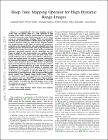| dc.contributor.author | Smolic, Aljosa | |
| dc.contributor.author | Rana, Aakanksha | |
| dc.contributor.author | Singh, Praveer | |
| dc.contributor.author | Valenzise, Giuseppe | |
| dc.contributor.author | Dufaux, Frederic | |
| dc.contributor.author | Komodakis, Nikos | |
| dc.date.accessioned | 2020-02-18T16:51:35Z | |
| dc.date.available | 2020-02-18T16:51:35Z | |
| dc.date.issued | 2019 | |
| dc.date.submitted | 2019 | en |
| dc.identifier.citation | Rana, A., Singh, P., Valenzise, G., Dufaux, F., Komodakis, N. & Smolic, A., Deep Tone Mapping Operator for High Dynamic Range Images, IEEE Transaction of Image Processing, 29, pp. 1285-1298, 2019, ISBN: 1057-7149., 2019 | en |
| dc.identifier.other | Y | |
| dc.identifier.uri | https://ieeexplore.ieee.org/document/8822603 | |
| dc.identifier.uri | http://hdl.handle.net/2262/91575 | |
| dc.description | PUBLISHED | en |
| dc.description.abstract | A computationally fast tone mapping operator (TMO) that can quickly adapt to a wide spectrum of high dynamic range (HDR) content is quintessential for visualization on varied low dynamic range (LDR) output devices such as movie screens or standard displays. Existing TMOs can successfully tone-map only a limited number of HDR content and require an extensive parameter tuning to yield the best subjective-quality tone-mapped output. In this paper, we address this problem by proposing a fast, parameter-free and scene-adaptable deep tone mapping operator (DeepTMO) that yields a high-resolution and high-subjective quality tone mapped output. Based on conditional generative adversarial network (cGAN), DeepTMO not only learns to adapt to vast scenic-content (e.g., outdoor, indoor, human, structures, etc.) but also tackles the HDR related scene-specific challenges such as contrast and brightness, while preserving the fine-grained details. We explore 4 possible combinations of Generator-Discriminator architectural designs to specifically address some prominent issues in HDR related deep-learning frameworks like blurring, tiling patterns and saturation artifacts. By exploring different influences of scales, loss-functions and normalization layers under a cGAN setting, we conclude with adopting a multi-scale model for our task. To further leverage on the large-scale availability of unlabeled HDR data, we train our network by generating targets using an objective HDR quality metric, namely Tone Mapping Image Quality Index (TMQI). We demonstrate results both quantitatively and qualitatively, and showcase that our DeepTMO generates high-resolution, high-quality output images over a large spectrum of real-world scenes. Finally, we evaluate the perceived quality of our results by conducting a pair-wise subjective study which confirms the versatility of our method. | en |
| dc.language.iso | en | en |
| dc.rights | Y | en |
| dc.subject | High Dynamic Range images | en |
| dc.subject | Tone mapping | en |
| dc.subject | Generative adversarial networks | en |
| dc.title | Deep Tone Mapping Operator for High Dynamic Range Images | en |
| dc.title.alternative | IEEE Transaction of Image Processing, 29 , pp. 1285-1298, 2019, ISBN: 1057-7149. | en |
| dc.type | Conference Paper | en |
| dc.contributor.sponsor | SFI stipend | en |
| dc.type.supercollection | scholarly_publications | en |
| dc.type.supercollection | refereed_publications | en |
| dc.identifier.peoplefinderurl | http://people.tcd.ie/smolica | |
| dc.identifier.rssinternalid | 212579 | |
| dc.identifier.doi | 10.1109/TIP.2019.2936649 | |
| dc.rights.ecaccessrights | openAccess | |
| dc.contributor.sponsorGrantNumber | 15/RP/2776 | en |
| dc.subject.TCDTheme | Creative Technologies | en |
| dc.subject.TCDTag | Multimedia & Creativity | en |
| dc.subject.darat_impairment | Other | en |
| dc.status.accessible | N | en |




